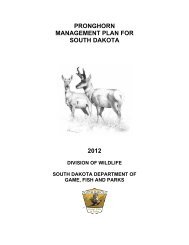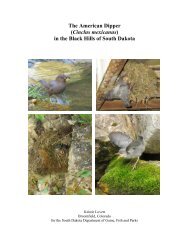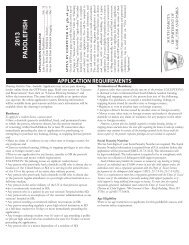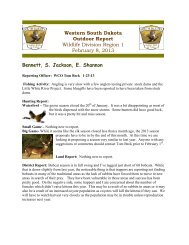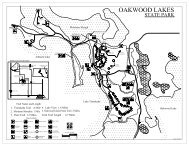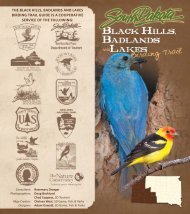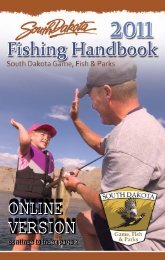pdf version - South Dakota Department of Game, Fish and Parks
pdf version - South Dakota Department of Game, Fish and Parks
pdf version - South Dakota Department of Game, Fish and Parks
You also want an ePaper? Increase the reach of your titles
YUMPU automatically turns print PDFs into web optimized ePapers that Google loves.
Walleye<br />
S<strong>and</strong>er vitreus<br />
Quick key characteristics: The walleye is found in primarily cool-water<br />
habitats. Its scales are moderate in size <strong>and</strong> readily visible. It has two,<br />
separated <strong>and</strong> elongated dorsal fi ns, one (in front) with sharp spines instead<br />
<strong>of</strong> rays. Its second dorsal fi n has one spine <strong>and</strong> the anal fi n has two. It has a<br />
large, forward-facing mouth that extends backward to near the rear margin <strong>of</strong><br />
the large eyes, large jaw teeth, <strong>and</strong> a pointed snout. Its body is tubular.<br />
Similar species in <strong>South</strong> <strong>Dakota</strong>: sauger, saugeye<br />
Identifi cation: The combination <strong>of</strong> (1) a deeper, heavier body, (2) a large<br />
black spot isolated near the rear base <strong>of</strong> the fi rst dorsal fi n (not widespread<br />
<strong>and</strong> abundant on both dorsal fi ns), (3) lower lobe <strong>of</strong> tail (caudal) fi n <strong>and</strong><br />
lower anal fi n milky white, <strong>and</strong> (4) a longer second dorsal fi n help distinguish<br />
the walleye from sauger. However, these species may hybridize in nature,<br />
making visual identifi cation impossible.<br />
Range: The walleye is native to northeastern North America from near the Arctic<br />
Circle to the Gulf <strong>of</strong> Mexico. There is some debate as to whether the walleye<br />
is native throughout <strong>South</strong> <strong>Dakota</strong>, but we believe (with little doubt) that it is.<br />
However, the species is widely stocked to enhance sport fi sheries.<br />
Items <strong>of</strong> interest:<br />
• Feeds primarily on fi shes, insects, <strong>and</strong> crustaceans<br />
• May undergo extensive spring spawning<br />
migrations to beaches or into streams in<br />
search <strong>of</strong> areas with clean gravel<br />
• Avoids bright light due to sensitive<br />
eyes, well adapted for feeding in deep or<br />
turbid water or during the dark <strong>of</strong> night<br />
• May exceed 30 in. <strong>and</strong> reach 15 lbs.<br />
63








